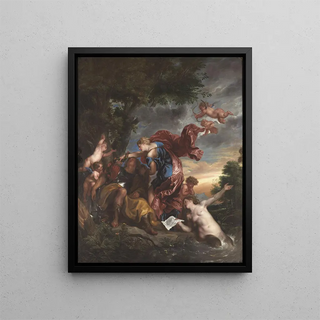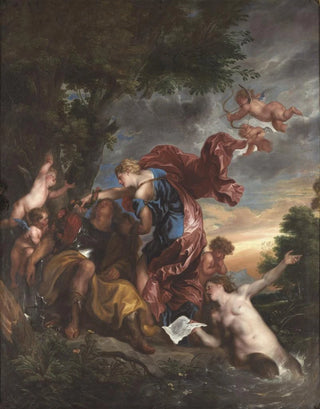Painting Rinaldo et Armida - Antoine van Dyck | Art print


View from behind

Frame (optional)
In the captivating world of baroque art, the "Rinaldo and Armida" art print by Antoine van Dyck stands out for its emotional intensity and narrative richness. This iconic canvas, depicting a scene from the medieval epic "Jerusalem Delivered" by Torquato Tasso, transports the viewer into a world where love and conflict intertwine with such force that they become palpable. The depiction of Rinaldo, the fearless knight, and Armida, the enchanting sorceress, evokes a dramatic tension that transcends mere pictorial framing. This masterpiece invites deep contemplation and immersion into human passions.
Style and uniqueness of the art print
Van Dyck's style is characterized by an exceptional mastery of painting techniques, but also by a unique sensitivity to light and color. In "Rinaldo and Armida," warm and vibrant tones create an enchanting atmosphere, emphasizing the beauty of the characters. The sumptuous drapery of Armida's garments, contrasting with Rinaldo's shining armor, demonstrates meticulous attention to detail and a keen understanding of textures. The dynamic composition, where bodies intertwine gracefully, reinforces the idea of movement and passion. This art print does not merely depict a scene; it captures an emotion, a fleeting moment where love and seduction oppose war and honor.
The artist and his influence
Antoine van Dyck, a pupil of Rubens, is one of the most influential artists of the 17th century. His ability to combine portraiture and pictorial storytelling marked his era and continues to inspire subsequent generations. With "Rinaldo and Armida," he goes beyond a simple illustration of a story, transcending the narrative to offer a reflection on human nature. Van Dyck mastered integrating psychological elements into his portraits, making his characters not only visible but also profoundly human. His influence extends beyond painting, touching fields such as sculpture and literature, where the emotional depth of his work continues to resonate.

Matte finish

View from behind

Frame (optional)
In the captivating world of baroque art, the "Rinaldo and Armida" art print by Antoine van Dyck stands out for its emotional intensity and narrative richness. This iconic canvas, depicting a scene from the medieval epic "Jerusalem Delivered" by Torquato Tasso, transports the viewer into a world where love and conflict intertwine with such force that they become palpable. The depiction of Rinaldo, the fearless knight, and Armida, the enchanting sorceress, evokes a dramatic tension that transcends mere pictorial framing. This masterpiece invites deep contemplation and immersion into human passions.
Style and uniqueness of the art print
Van Dyck's style is characterized by an exceptional mastery of painting techniques, but also by a unique sensitivity to light and color. In "Rinaldo and Armida," warm and vibrant tones create an enchanting atmosphere, emphasizing the beauty of the characters. The sumptuous drapery of Armida's garments, contrasting with Rinaldo's shining armor, demonstrates meticulous attention to detail and a keen understanding of textures. The dynamic composition, where bodies intertwine gracefully, reinforces the idea of movement and passion. This art print does not merely depict a scene; it captures an emotion, a fleeting moment where love and seduction oppose war and honor.
The artist and his influence
Antoine van Dyck, a pupil of Rubens, is one of the most influential artists of the 17th century. His ability to combine portraiture and pictorial storytelling marked his era and continues to inspire subsequent generations. With "Rinaldo and Armida," he goes beyond a simple illustration of a story, transcending the narrative to offer a reflection on human nature. Van Dyck mastered integrating psychological elements into his portraits, making his characters not only visible but also profoundly human. His influence extends beyond painting, touching fields such as sculpture and literature, where the emotional depth of his work continues to resonate.
12,34 €






